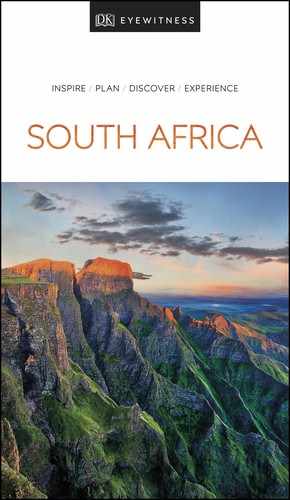Experience More
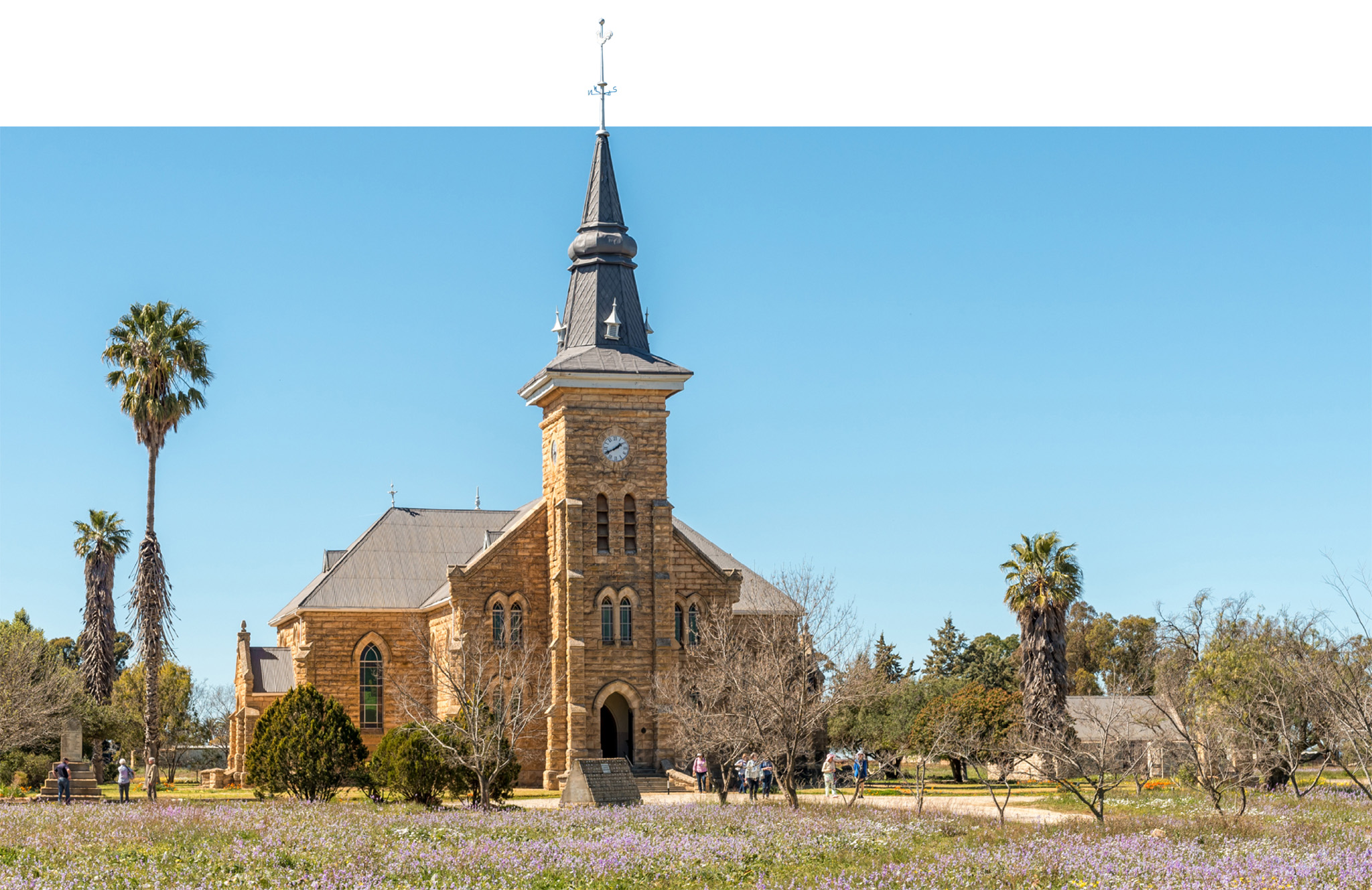
t Nieuwoudtsville’s sandstone Dutch Reformed Church
Nieuwoudtville stands on semi-desert plains known as the Bokkeveld (Land of Antelope), after the herds of migratory wildlife it once attracted. Its cluster of sandstone buildings include a Neo-Gothic Dutch Reformed Church dating from 1906–7. Nieuwoudtville comes into its own in spring, when wildflower displays are dominated by the world’s largest diversity of geophytes (plants with bulbs, corms or tubers). The best wildflower routes vary by week and season, so seek local advice, but the Nieuwoudtville Wildflower Reserve and Hantam National Botanical Garden are both reliable sites.
Just outside town, the Nieuwoudtville Falls can be spectacular after spring or summer rains, but is usually dry in winter. The world’s second-largest kokerboom (quiver tree) forest lies about 25 km (15 miles) to the northeast.

Insider Tip
Flower Spotting
Consult Namaqualand Tourism (namaqualand.com) to find the best viewing areas. Flowers open only on sunny days, and look their best between 11am and 4pm; drive facing them, with the sun behind you.
The southern gateway to Namaqualand, Vanrhynsdorp was founded as a mission called Trutro in 1751 and renamed after the prominent Van Rhyn family 130 years later. The original 18th-century Trutro House – later converted to a Dutch Reformed Church – can still be seen, while the Van Rhyn Museum, housed in a building from 1897, focuses on local history. Vanrhynsdorp lies in a succulent-dominated semi-desert known, somewhat ominously, as the Knersvlakte (literally, “Gnashing Plains”) in reference to the crunching sound made by wagon wheels as they traversed its surface of quartzite gravel. This dry country ecosystem is known both for dramatic spring wildflower displays and for the unique dwarf plants that grow here. It was finally accorded official protection in 2014 with the proclamation of the vast Knersvlakte Nature Reserve (not yet formally open to the public, though parts are accessible by public road).
Established in 1999 and extended to cover 1,410 sq km (544 sq miles) in 2008, this national park is centred on the Skilpad Wildflower Reserve, which erupts into a dazzling extravaganza of spring flowers from July through September. The park’s attractions are more nuanced at other times of year, but still appealing. Rocky plains traversed by walking and biking trails slope down to the scenic coastline between the Groen and Sproeg river mouths. Wildlife includes springbok and baboon, and several dry country endemics are found on the bird checklist of 150 species.
EXPERIENCE The Arid Northwest
Namaqualand
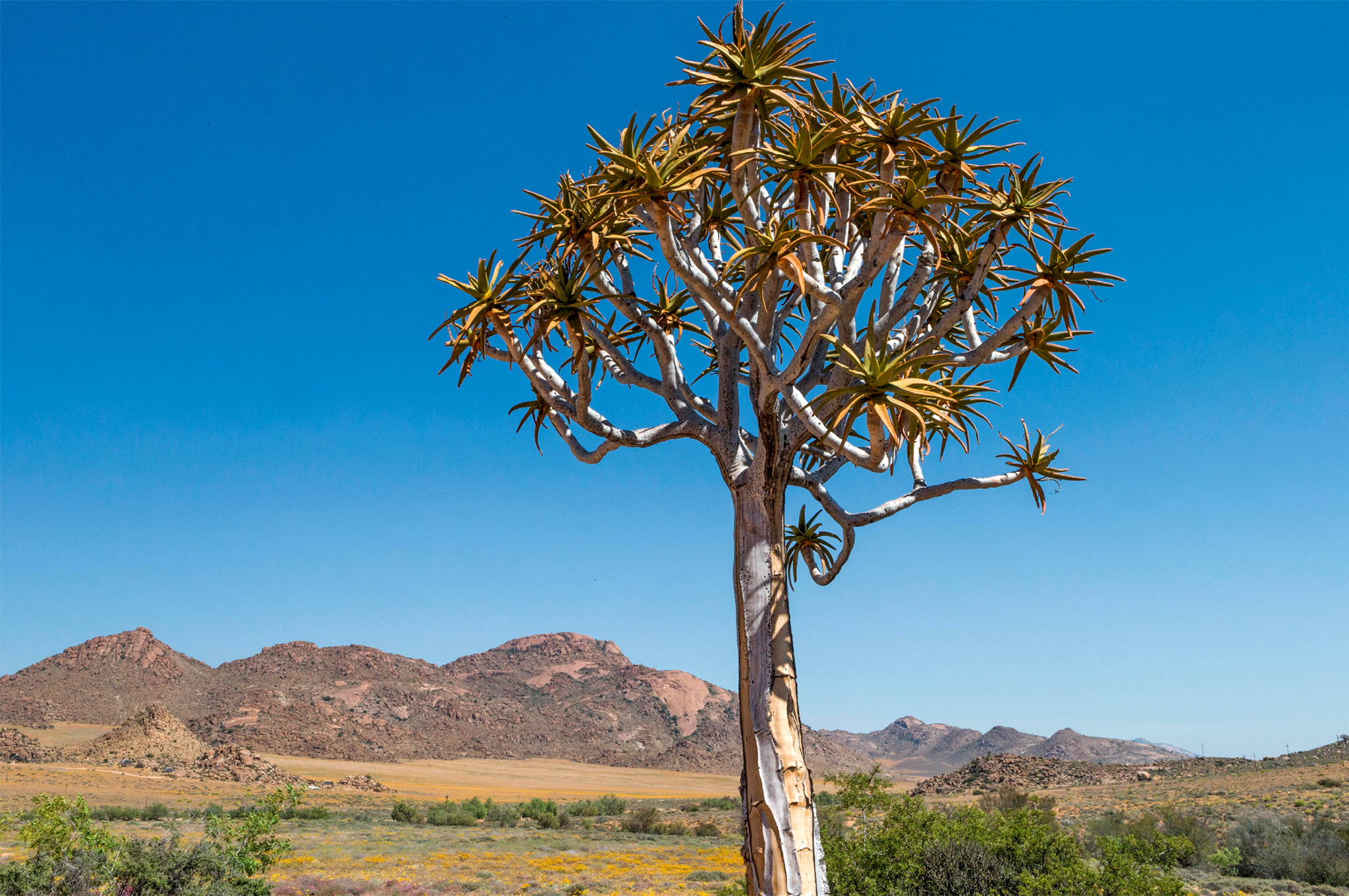
t A kokerboom, or quiver tree, with characteristic spiky leaves
Extending over 48,000 sq km (18,500 sq miles) between the Olifants and Orange rivers, Namaqualand is a region of sharp seasonal contrasts. For most of the year, its cover of rocky semi-desert shows few signs of floral activity. But come spring, a scattering of rain transforms it into a blaze of colour – pink, yellow, purple, orange – as a bewildering diversity of daisies and flowering succulents come into blossom.
Springflower displays are the most flamboyant facet of the floral wealth that has led to the Succulent Karoo of Namaqualand being listed among the world’s top 34 biodiversity hotspots. Of its estimated 3,000-4,000 plant species, half are endemic, while 17 per cent are on the IUCN Red Data List. Drought-resistant annuals include daisy-like Ursinias such as botterblom (butter flower) and gousblom (goose flower). Succulents are well-represented, most famously the carpet-like vygies (mesembryanthemums) and oddities such as the forbidding kokerboom, a tree aloe whose spiked crown protrudes skywards like fortifications.

t A colourful carpet of flowering daisies in Goegap Nature Reserve
EXPERIENCE The Arid Northwest

Wildflower Sites
Namaqua National Park
The higher rainfall resulting from the park’s proximity to the West Coast guarantees excellent displays of bright orange daisies and gazanias.
Postberg Nature Reserve
Located in the West Coast National Park, this popular flower-viewing spot is an easy day-trip from Cape Town.
Goegap Nature Reserve
Situated 15 km (9 miles) east of Springbok, the Goegap Nature Reserve’s flat plains and granite koppies support hundreds of succulents.
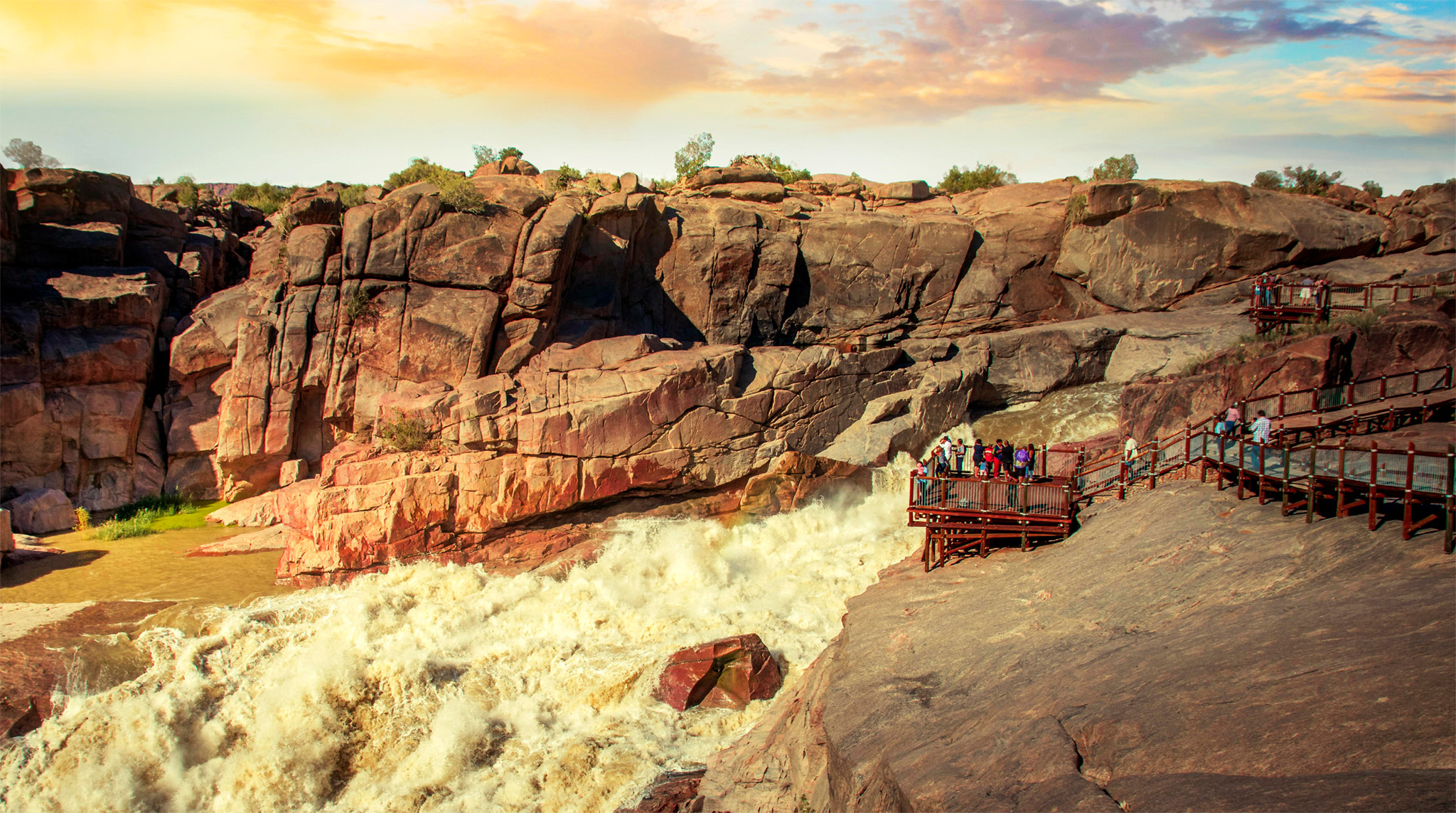
t Dramatic terrain in Augrabies Falls
This national park was founded in 1966 to protect the Augrabies Falls, which rush through the largest granite gorge in the world. During periods of normal flow, the main waterfall plunges 56 m (182 ft) into the gorge. The lesser Bridal Veil Waterfall, along the northern wall of the gorge, cascades 75 m (244 ft) into the river.
At the main complex near the entrance to the park stands a shop, restaurant and bar. Paths lead from here down to the falls. There are safety fences to prevent visitors from falling into the chasm, but you should take care near the waterfall, as the rocks are very slippery.
Apart from the waterfall itself and the attractive rest camp, Augrabies has much to offer. The 39-km (24-mile) Klipspringer Trail explores the southern section of the park and affords superb views of the gorge and surrounding desert. Wildlife to look out for includes klipspringer and kudu.

t National Park, a popular hiking spot
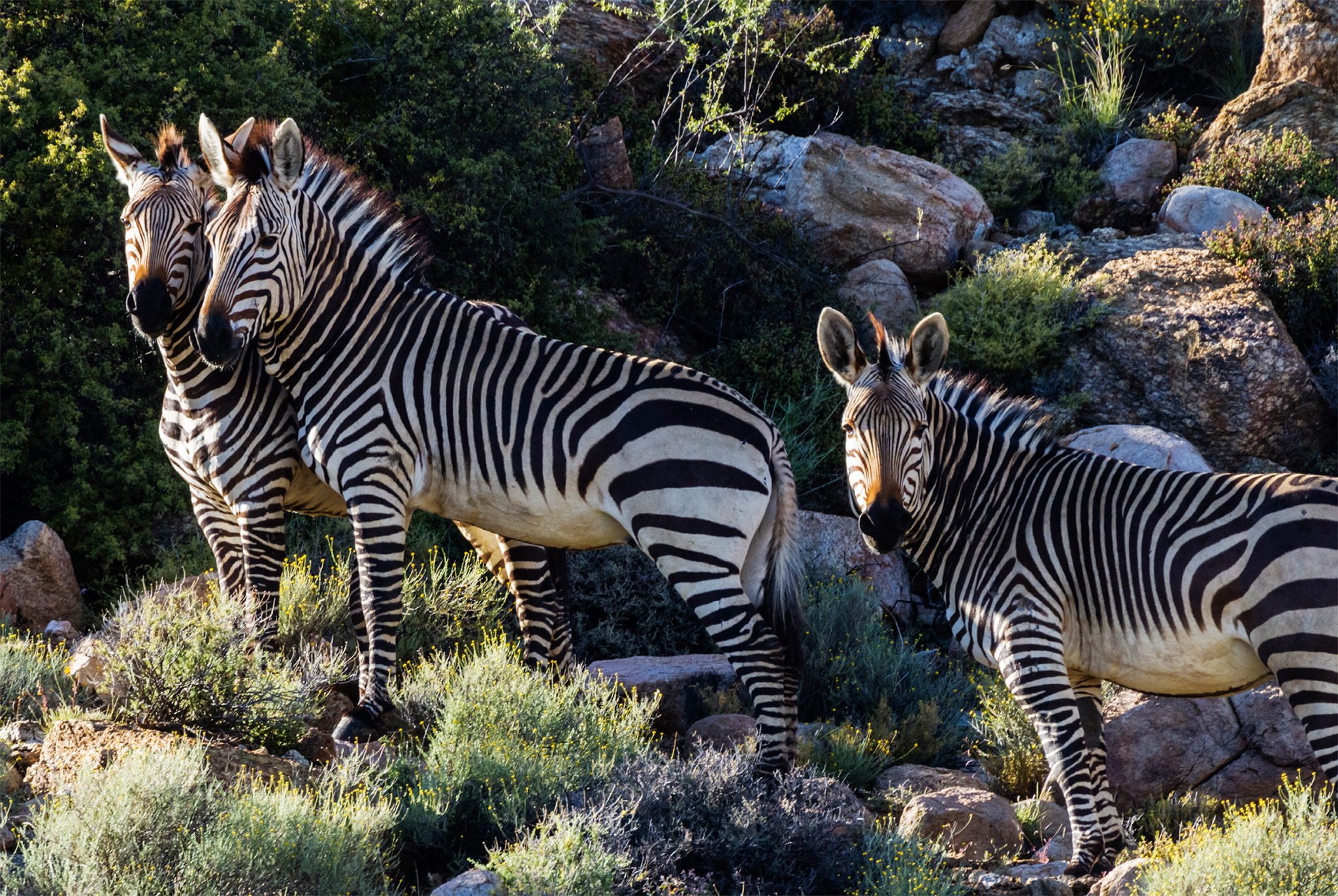
t A herd of Hartmann’s mountain zebra grazing in Goegap Nature Reserve near Springbok
A favoured tramping ground for self-sufficient 4WD enthusiasts, the Richtersveld is a true desert: searingly hot by day and surprisingly chilly at night, with some areas receiving an annual average rainfall of less than 5 mm (0.19 inches). Antelope such as gemsbok and springbok are present, together with several bird species endemic to the arid west, but for most visitors the primary attraction is the park’s uncompromised wilderness feel. Also on display are some peculiar native plants, most strikingly the halfmens (half-human) tree, which resembles a hunchbacked person in silhouette.
Richtersveld amalgamated with Namibia’s Ai–Ais Hot Springs Game Park in 2003, to form a vast 6,045-sq-km (2,334-sq-mile) transfrontier park bisected by the Orange River. The Richtersveld Community Conservancy, immediately south of the park and considered to be in more pristine condition, was inscribed as a UNESCO World Heritage Site in 2005.
Augrabies’s Leaping Lizard
Regularly seen scurrying around the granite rocks of the main viewpoint over Augrabies Falls, the range-restricted Broadley’s flat lizard is a Northern Cape endemic. This brightly coloured little creature is remarkable not only for the male’s kaleidoscopic scale pattern, but also for its acrobatic ability to leap high in the air to catch flying insects.
Springbok, self-styled capital of Namaqualand, can lay fair claim to being the most remote town of comparable size in South Africa. Founded in 1850, it owes its existence to the combination of wealthy copper deposits and a water supply adequate to support mining operations. The nearby Goegap Nature Reserve, traversed by a short road loop, is home to 600 plant, 45 mammal and 95 bird species, including South Africa’s only population of Hartmann’s mountain zebra (a species otherwise restricted to Namibia). Within the reserve, Hester Malan Wildflower Garden showcases a wealth of local succulents and is brightened by dazzling wildflower displays in spring.
Only 8 km (5 miles) north of Springbok, Okiep is South Africa’s oldest working mining town, founded in around 1869 to exploit what were then the world’s largest known copper deposits. Relicts of these days include a Cornish Beam Pump, built in 1882 to keep the mine dry, and a tall ventilation tower of similar vintage.

Insider Tip
The Augrabies Rush
Thrill-seekers should check out this four-hour rafting trip, which takes in several patches of rapids along a scenic stretch of the Orange River (www.kalahari-adventures.co.za).
Head north from Springbok along the N7 as far as Steinkopf, turn left onto a quiet asphalt road that leads across the Annienous Pass, and you will emerge at the sleepy fishing village of Port Nolloth. First developed in 1855 to ship out copper ore carried there by horse-drawn cart from Springbok, the village’s sheltered harbour was expanded in 1876 following the opening of a 154-km (96-mile) narrow-gauge railway from Okiep. It enjoyed a second lease of life in 1926 with the discovery of alluvial diamond deposits around the Orange River Mouth 85 km (53 miles) to the north.
Today, Port Nolloth has a charming, resort-that-time-forgot atmosphere, which is enhanced by sensational sunsets over the Atlantic Ocean; a strong Portuguese influence (from Angola) in the seafood-dominated cuisine; and a surrounding of dune-lined beaches and lagoons notable for their marine birdlife. The Port Nolloth Museum, housed in a 19th-century building, explores the region’s history.

t Nieuwoudtsville’s sandstone Dutch Reformed Church
An ambitious project without equal, Tswalu is South Africa’s largest private reserve. It protects around 750 sq km (285 sq miles) of red Kalahari dunes and the picturesque Korannaberg mountains. The reserve came into existence through the tireless efforts of British businessman Stephen Boler. First, he bought and amalgamated 26 cattle farms. Work teams then removed some 800 km (500 miles) of fencing from the land, as well as 2,300 km (1,440 miles) of electric lines, 38 concrete dams and the farmsteads. Thousands of cattle were sold off and the reserve was fenced.
Boler invested R54 million to develop the reserve. A total of 4,700 animals, representing 22 species, have been reintroduced, including lion, cheetah, buffalo, three types of zebra, blue and black wildebeest, red hartebeest, giraffe, gemsbok, kudu, impala and wild dog. But the jewels in Tswalu’s crown are, without doubt, the small number of desert black rhino (subspecies Diceros bicornis bicornis), relocated with the permission of the Namibian government. The reserve is now owned by the wealthy Oppenheimer family (of gold and diamond mining fame).
Tswalu’s two luxury, all-inclusive lodges have their own airstrip, and most visitors arrive by charter plane.
The gateway to the Northern Cape coming from Gauteng, the modest town of Kuruman owes its existence to the 20 million litres (5.3 million gallons) of clear, drinkable water that flow from a natural spring known as Die Oog (The Eye). The spring empties into a lily-covered pool that supports a variety of aquatic life, including a rare cichlid species, and attracts plenty of birds.
Improbable though it might seem today, this was one of the first parts of the South African interior to be explored by Europeans. The Kuruman Mission, founded by Robert Moffat in 1821, later became the first African posting held by the missionary and future explorer David Livingstone. The stump of the tree beneath which Livingstone proposed to Robert’s daughter Mary still stands, as does the church – then seven years old – where they were wed in 1845, and the old homestead where Robert Moffat and his family lived. The leafy mission grounds and their old stone buildings –which are open to visitors – exude a tranquil and historic ambience that is at odds with these otherwise harsh surrounds.
EXPERIENCE The Arid Northwest
|
Stay Le Must Residence A beautiful Georgian-style house set on the banks of the Orange River. The gardens are immaculate and the decor stylish. ⌂ 12 Murray Ave, Upington ∑ lemustupington.com |

t The sun setting over Upington, which is surrounded by wide plains
Originally established in 1870 as a mission station, the bustling town of Upington lies in a vast plain dotted with low shrubs. Only where the road reaches the Orange River does the landscape change abruptly, as the river paints a wide green stripe across the barren territory. As the second-largest settlement in the Northern Cape after Kimberley, Upington serves a district of lucerne, cotton, fruit and wine farms, which line a fertile corridor along the river.
In the late 19th century the Northern Cape was a wild frontier. The nomadic bands of Khoi hunter-gatherers resented the intrusion of the white settlers into this region and frequently stole livestock from them. In 1871, however, at the request of Korana chief Klaas Lukas, the Reverend Christiaan Schröder established a mission station in the wilderness and the first irrigation canals were dug. His original church is part of the Kalahari-Oranje Museum. Here too, is the statue of a camel and rider that honours the policemen and their tireless mounts who once patrolled this desert region.
Occupying an island in the Orange River, just outside town, Die Eiland is a municipal resort which has an avenue of more than 200 palm trees that were planted in 1935.
The five wine cellars in this arid region all belong to the Orange River Cellars, which offers tastings alongside complementary snack platters. On the southern bank of the river, the South African Dried Fruit Co-op on Louisvale Road is capable of processing up to 250 tonnes of dried fruit daily.
Kalahari–Oranje Museum
⌂ 4 Schröder St § 054 332 6064 # 9am–12:30pm & 2–5pm Mon–Fri; 9am–noon Sat
"
Orange River Cellars
⌂ 158 Schröder St # Tastings: 10am–5pm Mon–Fri, 10am–2pm Sat ∑ orangeriverwines.com
Did You Know?
The Orange River contains hidden treasure in the form of diamond deposits along its shores.
EXPERIENCE The Arid Northwest
|
Stay Castle in Clarens Built to resemble a fairytale castle, this boutique hotel is a fantasy lover’s delight. ⌂ Bokpoort Farm, R712, Clarens ∑ castleinclarens.co.za Golden Gate Hotel This 70s-style hotel underwent an Africa-themed makeover in 2013, and offers lush views over the park. ⌂ Golden Gate National Park ∑ goldengatehotel.co.za Liedjiesbos B&B An innovative guesthouse that combines airy modern architecture with African and Eastern-influenced decor. ⌂ 13 Frans Kleynhans Rd, Bloemfontein ∑ bloemfonteinaccommodation.biz |
The Karoo National Park was established on the outskirts of Beaufort West in 1979, to conserve a representative sample of the region’s unique heritage. It has been enlarged over the years and now encompasses vast, flat plains as well as the rugged Nuweveld Mountains. Animals such as mountain reedbuck, grey rhebok, kudu, steenbok, jackal and aardwolf occur naturally, while reintroduced species include lion, springbok, hartebeest, gemsbok (oryx), black wildebeest, Cape mountain zebra and the endangered riverine rabbit. Some 196 bird species have been recorded, and the park is well known for sustaining more than 20 Verreaux’s (black) eagle pairs.
A comfortable rest camp is situated at the base of the Nuweveld Mountains. Its spacious Cape Dutch chalets provide a convenient overnight stop that is easily accessible from the N1. The camp has good facilities, including a shop, swimming pool, restaurant and caravan park. Nearby, the historic Ou Skuur Farmhouse contains the park’s information centre. A 4WD trail has been laid out in the rugged western region of the park, and night drives here provide the very best chances of seeing many of the region’s shy nocturnal animals, such as the aardwolf.
In addition to its plentiful wildlife population, the park is also home to an extremely rich fossil history. The short Fossil and Bossie trails are accessible from the rest camp and allow visitors to explore the Karoo’s fascinating 250-million-year-old geological history and its unique vegetation.
The 400-m (1,300-ft) Fossil Trail is especially popular; it is designed to accommodate wheelchairs and incorporates Braille boards and informative plaques. A bird hide and an easy hike of 3 km (2 miles) are also accessible from the rest camp.
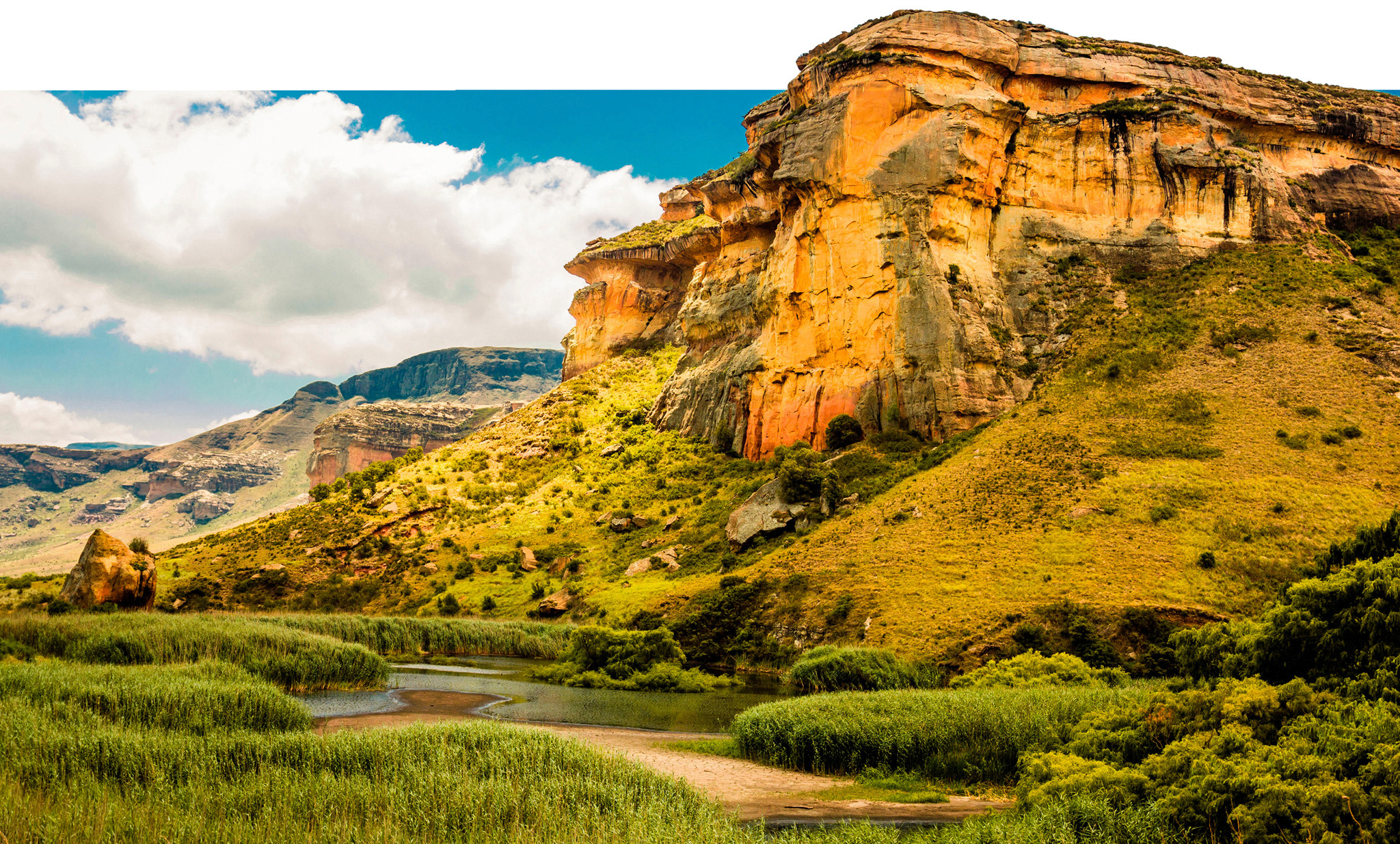
t Dramatic sandstone cliffs dominating the Golden Gate Highlands National Park
Far less developed than its KwaZulu-Natal counterpart, the western Drakensberg – also known as Maloti – is nevertheless very scenic. Set within unglamorous Free State province, the region’s closest approximation of a resort town is Clarens, which stands in a lush valley below a striking sandstone cliff nicknamed Titanic Rock. Founded in 1911 and named after the Swiss town where President Paul Kruger spent his last years in voluntary exile, today Clarens supports a thriving art colony and is a great base for outdoor activities, from trout fishing and canoeing to hiking and mountain biking.
Clarens is also the springboard for Golden Gate Highlands National Park, which encompasses 340 sq km (131 sq miles) of grassland and sandstone formations in the Maloti foothills. Proclaimed in 1963, the park is named for its most distinctive feature, a magnificent pair of facing cliffs that take on a burnished hue towards sunset. Best explored on foot, this scenic park supports plenty of wildlife, notably black wildebeest, blesbok and eland, while birds in the area include the endangered bearded vulture, soaring Verreaux’s eagle and endemic southern bald ibis.
Rock art enthusiasts might consider basing themselves at Ladybrand, a quaint highland town set within striking distance of 300 different sites. The pick of the region is Tandjesberg, a national monument whose 530 individual painted images include polychrome elands, a group of female dancers, and an elephant whose trunk appears to morph into a human.
"
Golden Gate Highlands National Park
# 7am–5:30pm daily ∑ sanparks.org
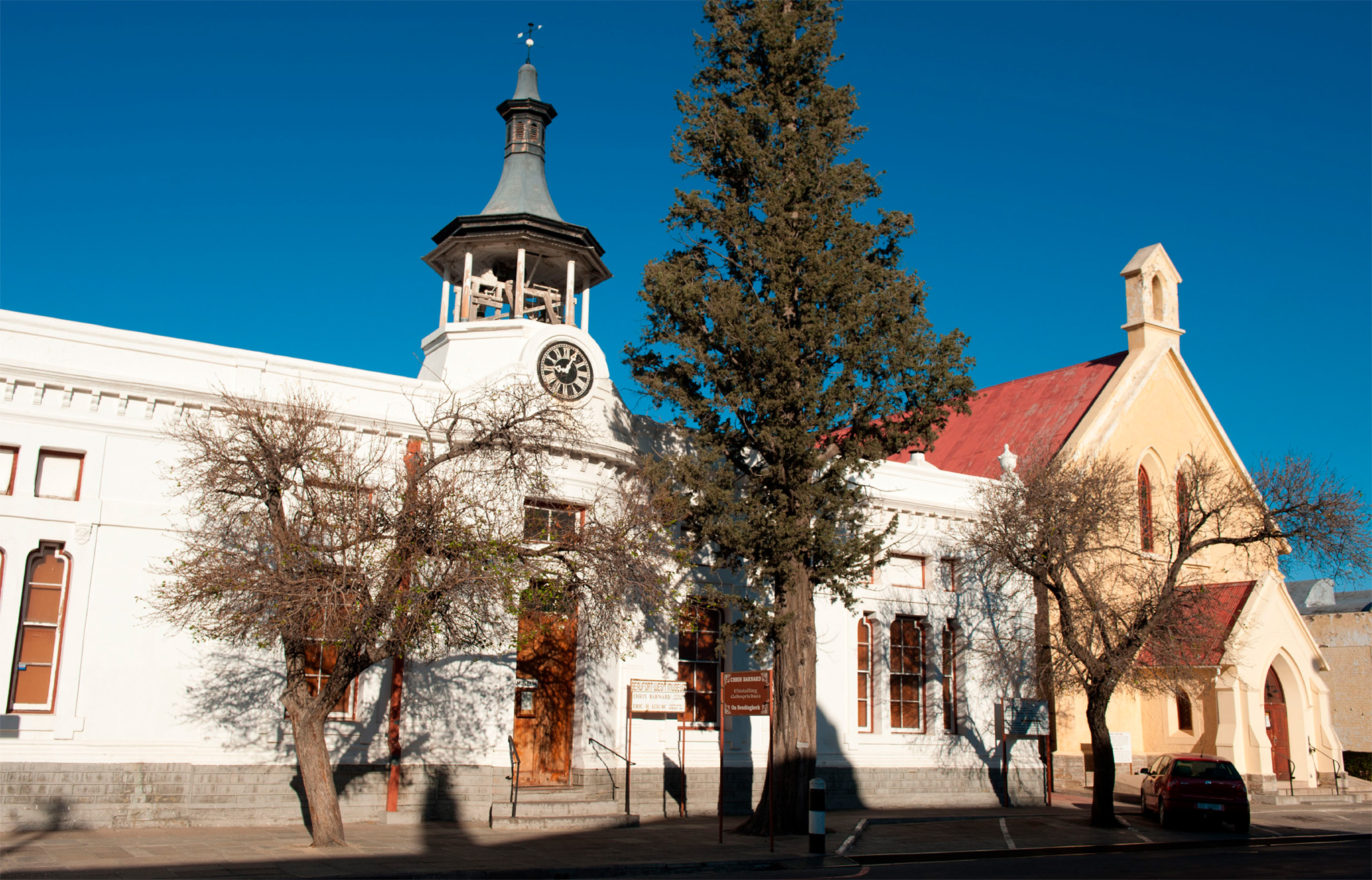
t The 19th-century Town Hall and Dutch Reformed Church in Beaufort West
The Karoo’s largest town, Beaufort West was founded in 1818 and its historic Donkin Street is lined with national monuments including the Neo-Gothic Dutch Reformed Church and the adjacent Town Hall. The surrounding semi-arid plains have thrived as a centre of sheep farming since the hardy merino breed was introduced in the 1840s, and even today Karoo lamb is a staple on local menus.
In Victorian times, Beaufort West’s dry climate made it a popular winter retreat for asthmatic Capetonians, but these days the town is of interest mainly as a convenient overnight stop between Johannesburg and Cape Town.

Insider Tip
The Cherry on Top
Situated halfway between Clarens and Ladybrand, the agricultural town of Ficksburg is known as the cherry capital of South Africa. It hosts a popular and enjoyable festival each year in mid-November, when the cherry season peaks.

t The Fourth Raadsaal, located on Bloemfontein’s central President Brand Street
Situated in the heartland of South Africa, Bloemfontein, capital of the Free State and seat of the province’s parliament, is also the country’s judicial capital. Part of the municipality of Mangaung, it lies at the hub of five national road routes. An altitude of 1,400 m (4,593 ft) means that summers are moderate and winters mild to cool.
The city was named after a fountain where early travellers used to stop on their treks through the interior. The city’s history – and that of many of its stately old sandstone buildings – is firmly connected with the Afrikaners’ struggle for independence. In 1854, when Major Henry Warden, the region’s official British representative, was recalled to the Cape, the Afrikaners established a republic, with Bloemfontein as its capital.
Although Major Warden’s fort has long disappeared, a portion of Queen’s Fort, dating back to 1848, can still be seen south of the city centre. President Brand Street is lined with many fine old sandstone buildings, such as the Appeal Court, built in 1929, opposite the Fourth Raadsaal, which now houses the Free State’s provincial legislature. This brick-and-sandstone building was constructed around 1893, during the presidency of Frederick Reitz.
Not far from the Appeal Court are two interesting museums. The National Museum contains a good collection of dinosaur fossils, and a reconstruction of a 19th-century Bloemfontein street, while the National Museum for Afrikaans Literature is devoted to leading Afrikaans writers.
Three blocks south from the Literature Museum stands the Old Presidency, an attractive building completed in 1861. It was the home of the republic’s Afrikaner presidents before the British invasion in 1900, and now houses a small museum with a pleasant café in the stables.
The oldest building in the city is the First Raadsaal Museum, a satellite of the National Museum. Built on Warden’s instructions in 1849, it was first used as a school, but after 1854 it became the meeting place of the republic’s Volksraad (people’s council).
Also in the city centre is the Tweetoringkerk (twin-spired church), which was dedicated in 1881. Unique in the country, it was inspired by Europe’s Gothic cathedrals. Inside, the decorative woodwork is especially noteworthy.
South of the city, the National Women’s Memorial and Anglo-Boer War Museum commemorates the countless Boer and black African women and children who died in British concentration camps during the South African War. Emily Hobhouse, a British woman who campaigned for better treatment of the prisoners, is buried at the foot of the monument.
North of the city centre, the Franklin Nature Reserve occupies Naval Hill, where, the University of Michigan built an observatory in 1928. Over 7,000 star systems were discovered before it closed in 1972. Further north still, the Oliewenhuis Art Museum has a superb collection of South African art.

t The National Museum for Afrikaans Literature
" - =
National Museum
⌂ 36 Aliwal St # 8am–5pm Mon–Fri, 10am–5pm Sat, noon–5:30pm Sun & pub hols ¢ Good Friday & 25 Dec ∑ nasmus.co.za
National Museum for Afrikaans Literature
⌂ 40 Merriam Makeba St § 051 405 4711 # 8am–4pm Mon–Fri
-
Old Presidency
⌂ President Brand St § 051 448 0949 # 10am–4pm Tue–Sat
First Raadsaal Museum
⌂ 95 St George St # 10am–1pm Mon–Fri, 2–5pm Sat & Sun ¢ Good Fri, 25 Dec ∑ nasmus.co.za
Tweetoringkerk
⌂ Charles St § 051 430 4274
"
National Women’s Memorial and Anglo-Boer War Museum
⌂ Monument Rd # 8am–5pm Mon–Fri, 10am–5pm Sat, 11am–5pm Sun ∑ wmbr.org.za
Franklin Nature Reserve
⌂ 2–22 Delville Dr, Naval Hill # 7am–6pm daily
Oliewenhuis Art Museum
⌂ Harry Smith St § 051 447 9609 # 8am–5pm Mon–Fri, 9am–4pm Sat & Sun # Good Fri, 25 Dec

t Flowers by Walter Altman, Oliewenhuis Art Museum
Did You Know?
Bloemfontein is more evocatively known in Sesotho as Mangaung, meaning “Place of Cheetahs”.
EXPERIENCE The Arid Northwest
|
EAT De Oude Kraal Country Estate & Spa A six-course set menu and excellent wine list provide gastronomic adventures at this high-ceilinged farmhouse with antique furniture. ⌂ N1, south of Bloemfontein ∑ deoudekraal.com Seven on Kellner Recently relocated close to the botanical garden, this veteran of 20-plus years combines fine dining with friendly service. ⌂ 2 Waverley Road, Bloemfontein § 051 447 7928 ¢ Sun |
